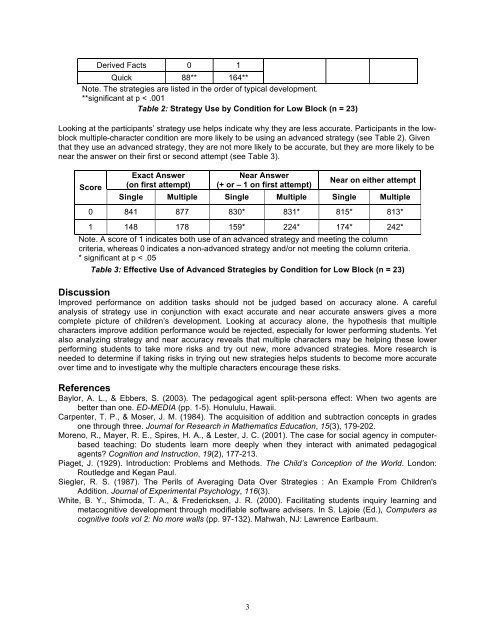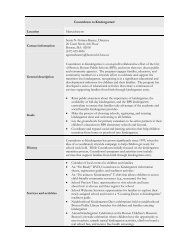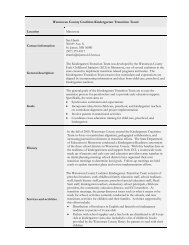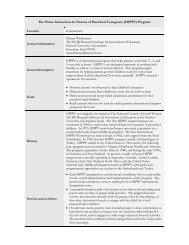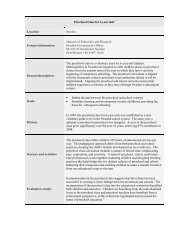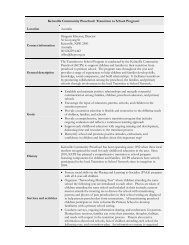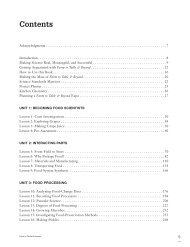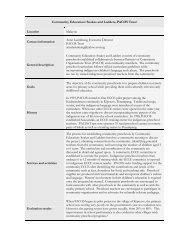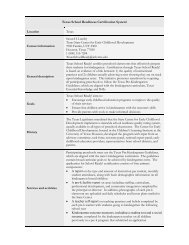Proceedings of the Fourth Annual Teachers College Educational ...
Proceedings of the Fourth Annual Teachers College Educational ...
Proceedings of the Fourth Annual Teachers College Educational ...
Create successful ePaper yourself
Turn your PDF publications into a flip-book with our unique Google optimized e-Paper software.
Derived Facts 0 1<br />
Quick 88** 164**<br />
Note. The strategies are listed in <strong>the</strong> order <strong>of</strong> typical development.<br />
**significant at p < .001<br />
Table 2: Strategy Use by Condition for Low Block (n = 23)<br />
Looking at <strong>the</strong> participants’ strategy use helps indicate why <strong>the</strong>y are less accurate. Participants in <strong>the</strong> lowblock<br />
multiple-character condition are more likely to be using an advanced strategy (see Table 2). Given<br />
that <strong>the</strong>y use an advanced strategy, <strong>the</strong>y are not more likely to be accurate, but <strong>the</strong>y are more likely to be<br />
near <strong>the</strong> answer on <strong>the</strong>ir first or second attempt (see Table 3).<br />
Score<br />
Exact Answer<br />
(on first attempt)<br />
Near Answer<br />
(+ or – 1 on first attempt)<br />
3<br />
Near on ei<strong>the</strong>r attempt<br />
Single Multiple Single Multiple Single Multiple<br />
0 841 877 830* 831* 815* 813*<br />
1 148 178 159* 224* 174* 242*<br />
Note. A score <strong>of</strong> 1 indicates both use <strong>of</strong> an advanced strategy and meeting <strong>the</strong> column<br />
criteria, whereas 0 indicates a non-advanced strategy and/or not meeting <strong>the</strong> column criteria.<br />
* significant at p < .05<br />
Table 3: Effective Use <strong>of</strong> Advanced Strategies by Condition for Low Block (n = 23)<br />
Discussion<br />
Improved performance on addition tasks should not be judged based on accuracy alone. A careful<br />
analysis <strong>of</strong> strategy use in conjunction with exact accurate and near accurate answers gives a more<br />
complete picture <strong>of</strong> children’s development. Looking at accuracy alone, <strong>the</strong> hypo<strong>the</strong>sis that multiple<br />
characters improve addition performance would be rejected, especially for lower performing students. Yet<br />
also analyzing strategy and near accuracy reveals that multiple characters may be helping <strong>the</strong>se lower<br />
performing students to take more risks and try out new, more advanced strategies. More research is<br />
needed to determine if taking risks in trying out new strategies helps students to become more accurate<br />
over time and to investigate why <strong>the</strong> multiple characters encourage <strong>the</strong>se risks.<br />
References<br />
Baylor, A. L., & Ebbers, S. (2003). The pedagogical agent split-persona effect: When two agents are<br />
better than one. ED-MEDIA (pp. 1-5). Honululu, Hawaii.<br />
Carpenter, T. P., & Moser, J. M. (1984). The acquisition <strong>of</strong> addition and subtraction concepts in grades<br />
one through three. Journal for Research in Ma<strong>the</strong>matics Education, 15(3), 179-202.<br />
Moreno, R., Mayer, R. E., Spires, H. A., & Lester, J. C. (2001). The case for social agency in computerbased<br />
teaching: Do students learn more deeply when <strong>the</strong>y interact with animated pedagogical<br />
agents? Cognition and Instruction, 19(2), 177-213.<br />
Piaget, J. (1929). Introduction: Problems and Methods. The Childʼs Conception <strong>of</strong> <strong>the</strong> World. London:<br />
Routledge and Kegan Paul.<br />
Siegler, R. S. (1987). The Perils <strong>of</strong> Averaging Data Over Strategies : An Example From Children's<br />
Addition. Journal <strong>of</strong> Experimental Psychology, 116(3).<br />
White, B. Y., Shimoda, T. A., & Fredericksen, J. R. (2000). Facilitating students inquiry learning and<br />
metacognitive development through modifiable s<strong>of</strong>tware advisers. In S. Lajoie (Ed.), Computers as<br />
cognitive tools vol 2: No more walls (pp. 97-132). Mahwah, NJ: Lawrence Earlbaum.


